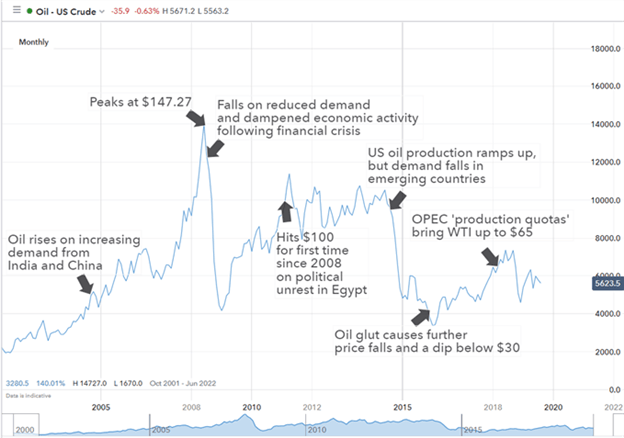Crude oil is a major global energy source and a widely-traded commodity. In this piece, we look at the origins and history of crude, the key factors that affect its price and the main reasons to trade this asset.
MAIN TALKING POINTS:
What is crude oil and what is it used for?
Main players in the crude oil market
Factors that affect oil prices
Advertisement
WHAT IS CRUDE OIL AND WHAT IS IT USED FOR?
Crude oil, or petroleum, is a naturally-occurring fossil fuel and currently the world’s primary energy source. It is made from ancient organic matter and can be distilled into component fuels such as gasoline, diesel, and lubricants, each of which have a multitude of industrial applications.
The commodity is usually extracted from underground reservoirs through drilling, and the countries that produce the greatest volume of crude oil, as of 2019, are the USA, Russia, and Saudi Arabia.
To understand how crude oil relates to other energy resources and assets, as well as how to trade them, visit our Major Commodities page.
BRENT AND WTI CRUDE OIL EXPLAINED
The composition of crude oil varies by source, but two types are used to benchmark global prices. They are the United States’ West Texas Intermediate (WTI) and United Kingdom’s Brent crude. The differences between them are based on factors such as composition, extraction location and prices, but for more details, as well as how to trade each asset, see our WTI vs Brent comparison.

RECOMMENDED BY BEN LOBEL
Understanding the Core Fundamentals of Oil Trading
Get My Guide
POWER PLAYERS IN THE CRUDE OIL MARKET
The Organization for Petroleum Exporting Countries (OPEC) was established in 1960. This body sets production quotas for its members, with the aim of reducing competition and keeping prices at profitable levels. OPEC is dominated by Kuwait, Qatar, Saudi Arabia (which controls the Strait of Hormuz
Institutions that supply oil to the global market are made up of international oil companies, or IOCs, such as ExxonMobil, BP and Royal Dutch Shell. These are investor-owned and look to increase shareholder value through private interests. However, national oil companies, or NOCs, such as Saudi Aramco and Gazprom, are fully or majority-owned by a national government.
For more about the power players and their role in global oil production, see our 8 Surprising Crude Oil facts.
RECOMMENDED BY BEN LOBEL
Building Confidence in Trading
Get My Guide
HISTORY OF CRUDE OIL
The history of crude oil has seen many changes since the beginning of the century, when global supply was largely controlled by OPEC, but demand was driven by the US. With OPEC calling the shots and Asian demand rising rapidly, prices went from a cost per barrel of $25 for Brent and $27 for WTI in March 2001, to $140 for both types by June 2008, representing a price bubble.
However, the last decade has seen technological advancements and deregulation facilitate increased US shale oil production, leading to shift in power from OPEC to the US. Prices fell from $112 for Brent and $105 for WTI in June 2014, to under $36 for both by January 2016. OPEC responded by colluding with several countries – including Russia – to implement ‘production quotas’ designed to stabilize prices. These brought the cost per barrel back above $70 for Brent, and $65 for WTI, by April 2018.
The below chart shows some key landmarks in the price of US Crude this century and the reasons for the swings.
WTI CRUDE OIL (2000-2019)

WHAT AFFECTS CRUDE OIL PRICES?
Crude oil prices are affected mostly by supply and demand, which in turn are influenced by factors such as outages, OPEC production cuts, seasonality, and changing consumption patterns. For more on these and why they are essential fundamental factors to understand when trading the asset, see our guide to trading crude oil.

RECOMMENDED BY BEN LOBEL
Download our most recent Oil Forecast
Get My Guide
USD AND THE PRICE OF OIL
The US Dollar and oil have historically had an inverse relationship. When USD is weak, the price of oil has traditionally been higher in dollar terms. Since the US was for long periods a net importer of oil, rising oil price has meant the US trade balance deficit has risen since more dollars are required to be sent abroad. However, some believe this relationship follows less reliable patterns in modern times.
There is a more predictable link between the Canadian Dollar and oil prices. For example, as of 2019, Canada exports some three million barrels of oil and petroleum products per day to the US, meaning a huge demand for Canadian dollars is created. If US demand rises, more oil is needed, which often means oil prices rise, and could accordingly mean a fall in USD/CAD. Conversely, if US demand falls, oil prices may fall too, meaning demand for CAD drops in turn.
Reasons to Trade Crude Oil
Oil is a dynamic, volatile and liquid market – and stands as the most traded commodity in the world. Here’s more on the benefits of engaging with this asset.
The volatile nature of trading this asset makes it a favorite of swing and day traders, who react to the latest oil pricing news. While the trading can be risky, some see the oil market as an opportunity in its purest form.
Crude oil is a liquid market, traded in huge volume. This means trades can be opened and closed at the price points you want and at lower trading cost.
Oil can be traded as part of a hedging strategy to mitigate against the effects of the asset’s volatility.
Trading oil can be part of a diversified portfolio of commodities, stocks and bonds.







